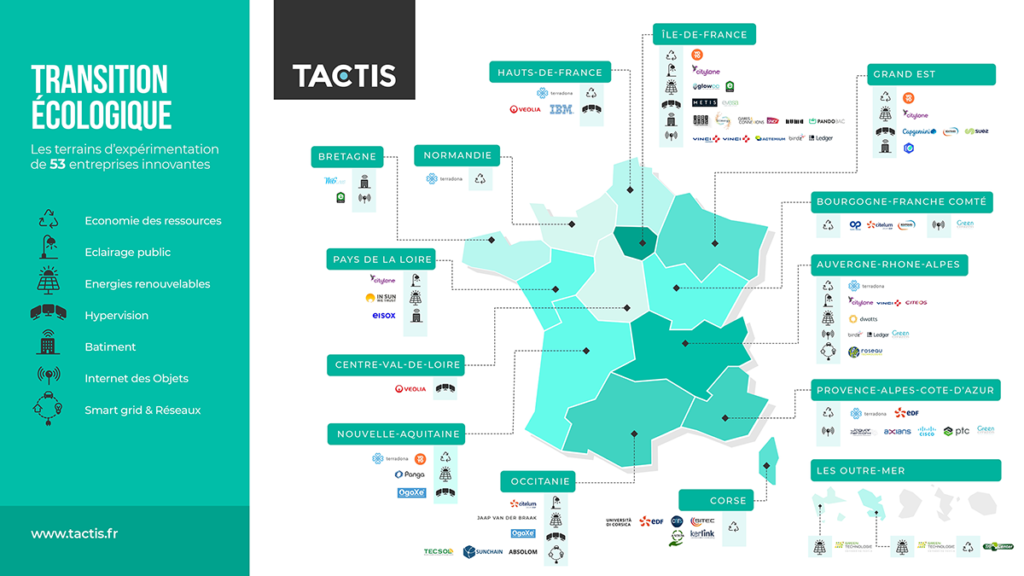On October 11, 2019, C40 Cities announced the signing of the "C40 Clean Air Cities Declaration." Thirty-five global cities "recognize that breathing clean air is a fundamental right and commit to working together to form a unique global coalition fighting for air quality."
Communities, at the heart of the ecological transition
Ecological transition strategies at the local level must involve citizens, businesses, associations, and local authorities. Thus, this transition incorporates a significant behavioral factor, both for officials and citizens, requiring tools to modify, support, and optimize public action, which will require rethinking the organization and management of the territory's networks and resources.
Datavisualisation: 37 innovative companies in the field of energy transition in France
The innovative companies listed in the Tactis Innovation Base offer solutions addressing various themes and meeting the expectations of communities and citizens. These themes reflect the development of offerings addressing:
Resource Savings: Optimizing resources used by communities and citizens.
Renewable Energies: Energy sources that renew themselves quickly enough to become inexhaustible.
Internet of Things: A set of connected objects enabling communities to process and use more information to improve efficiency.
Smart Grids and Networks: An electrical network that increases information sharing between stakeholders.
Street Lighting: Solutions aimed at optimizing lighting management in public spaces.
Connected Building : Solutions aimed at making buildings sustainable and environmentally friendly.
Hypervision : Software components enabling the cross-functional management of local government functions.
A key challenge: changing behaviors
One of the challenges of the ecological transition lies in changing behaviors and promoting eco-responsible actions (more conservative consumption of available resources, less energy-intensive production of goods and services, reduced waste production, waste recovery, etc.).
Many private players offer digital-based solutions to improve waste management. One example is the Cliiink Box in the Pays de Grasse region, a waste sorting management tool based on the Nudge principle to raise citizens' awareness of the importance of sorting. It can also involve reducing waste, and therefore consuming wisely.
This is the case for solutions that prevent food waste or electricity consumption. Another lever for action, in terms of resources, is to implement behavioral incentives to promote the production of green energy (solar, wind, etc.) or recycled materials.
In Toulouse, for example, an experimental project enabled the city to produce electricity using the kinetic energy of citizens as they walk along sidewalks equipped with micro-sensors.
Anticipating the energy transition with digital tools
The ecological transition can only be fully achieved with solutions that correct current behaviors. It also involves anticipating the future. This is particularly true when it comes to energy consumption, for example.
To this end, some local authorities have opted for digital tools that allow them to optimize their land management through anticipatory measures. This is why some local authorities are investing in an urban hypervision platform, one of whose objectives is to analyze and cross-reference territorial data to create action scenarios. Aix-en-Provence has therefore deployed more than 800 sensors to improve the restitution of data concerning pedestrian flows, lighting, air quality, noise, etc.
This data allows the community to better understand and anticipate events within the city, making local action more effective.
This type of tool can also be deployed to optimize the use of electricity networks. With this in mind, the city of Issy-Les-Moulineaux experimented with the implementation of a Smart Grid for six years. This improved understanding of a neighborhood's energy consumption while promoting information sharing between stakeholders (local authorities, citizens, real estate companies, energy companies, etc.).
Digital technology for better building and public lighting management
Improved management of public lighting and buildings are two key areas for improving energy efficiency. Today, there are many smart solutions to improve their management, particularly through the use of sensors and appropriate monitoring software.
In this respect, Clermont-Ferrand illustrates the effectiveness of these initiatives with a solution that allows the brightness of streetlights to be modulated according to various parameters: peak hours, location, traffic, etc.
In the building management sector, Grid & Edge Computing solutions integrated into buildings are emerging. This type of solution enables, among other things, the optimization of energy consumption, participatory incident reporting, and remote control of connected objects.
Finally, other solutions specialize in analyzing fluids within buildings to identify and address potential leaks as early as possible. Finally, some solutions even offer to heat buildings using the computing power of micro-data centers.
The Hypervision Challenge
"Hypervisor" solutions consist of several software components that enable the cross-functional management of business functions, which are currently most often managed in silos.
The main objective of a Hypervision platform is to enable cross-functional public action, i.e., to manage the city as a whole and not as a collection of separate areas (mobility, security, energy, crowd management, environmental sensors such as air quality, etc.).
The cross-functional management of these areas offers local authorities the opportunity to connect all the data collected across the territory to improve the effectiveness of decision-making. Implementing such a solution requires a comprehensive reflection on how the community operates and requires defining new, more collaborative ways of developing public action.

Nicolas Potier
Contact Nicolas Potier
Do you have a question about the role of digital technology in the ecological transition? Need to clear up any doubts about a future project? Send an email to Nicolas Potier, Associate Director at Tactis.


